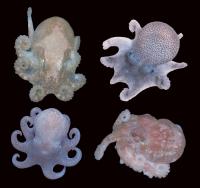
Bottom left: Megeleledone setebos, endemic to the Southern Ocean, surrounded by related octopus species that evolved in the deep-sea. In a report on progress towards the first Census of Marine Life, more than 2,000 scientists from 82 nations announce astonishing examples of recent new finds from the world's ocean depths.
As more than 500 delegates gather for the World Conference on Marine Biodiversity (Valencia, Spain Nov. 11-15), organized by the Census's European affiliate program on
Marine Biodiversity and Ecosystem Functioning, the report details major progress towards the first ever marine life census, for release in October, 2010. In Spain, renowned marine scientists will announce more new and surprising results daily throughout the event, to be opened with a news conference in Valencia Tues. Nov. 11.
In the fourth report issued since the global collaboration began in the year 2000, Census scientists say their work is:
- Compiling an unprecedented number of "firsts" for ocean biodiversity;
- Advancing technology for discovery;
- Organizing knowledge about marine life and making it accessible;
- Measuring effects of human activities on ocean life;
- Providing the foundation for scientifically-based policies;
According to Ian Poiner, chair of the Census's International Scientific Steering Committee and Chief Executive Officer of the Australian Institute of Marine Science, "The release of the first Census in 2010 will be a milestone in science. After 10 years of new global research and information assembly by thousands of experts the world over, it will synthesize what humankind knows about the oceans, what we don't know, and what we may never know – a scientific achievement of historic proportions."
"Dedication and cooperation are enabling the largest, most complex program ever undertaken in marine biology to meet its schedule and reach its goals. When the program began, such progress seemed improbable to many observers."
In 2010, the first global Census will relate:
- Distribution of animals in the ocean and their changing ranges;
- Diversity as the total number of species in the ocean (known and unknown);
- Abundance of major species groups and how they have changed over time;
With regard to distribution, the Census will offer:
- Range maps for known marine species;
- Major global traffic patterns of top marine species;
- Global maps of species richness, showing hotspots and the extent of biodiversity in the oceans
With regard to diversity, the Census will offer:
- A complete list of named marine species, likely to range between 230,000-250,000, as well as fresh estimates of species yet to be discovered;
- Web pages for the great majority of the named species, compiled in cooperation with the Encyclopedia of Life;
- DNA identifiers ("barcodes") for many species
With regard to abundance, the Census will offer:
- New estimates of biomass at various levels in the food chain and for selected species;
- Estimates of changes in the relative frequency of small versus large animals;
- Estimates of abundance that has been or might be lost soon.
Source : Census of Marine Life
 Print Article
Print Article Mail to a Friend
Mail to a Friend
